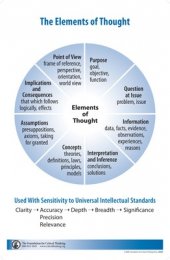To Analyze Thinking We Must Identify and Question its Elemental Structures
Standard: Clarity
understandable, the meaning can be grasped
Could you elaborate further?
Could you give me an example?
Could you illustrate what you mean?
Standard: Accuracy
free from errors or distortions, true
How could we check on that?
How could we find out if that is true?
How could we verify or test that?
Standard: Precision
exact to the necessary level of detail
Could you be more specific?
Could you give me more details?
Could you be more exact?
Standard: Relevance
relating to the matter at hand
How does that relate to the problem?
How does that bear on the question?
How does that help us with the issue?
Standard: Depth
containing complexities and multiple interrelationships
What factors make this a difficult problem?
What are some of the complexities of this question?
What are some of the difficulties we need to deal with?
Standard: Breadth
encompassing multiple viewpoints
Do we need to look at this from another perspective?
Do we need to consider another point of view?
Do we need to look at this in other ways?
Standard: Logic
the parts make sense together, no contradictions
Does all this make sense together?
Does your first paragraph fit in with your last?
Does what you say follow from the evidence?
Standard: Significance
focusing on the important, not trivial
Is this the most important problem to consider?
Is this the central idea to focus on?
Which of these facts are most important?
Standard: Fairness
Justifiable, not self-serving or one-sided
Do I have any vested interest in this issue?
Am I sympathetically representing the viewpoints of others?
More Standards:
There are numerous other standards that may be applied to elements on a contextual basis. Here are just a few:
Completeness, Validity, Rationality, Sufficiency, Necessity, Feasabilty, Consistency, Authenticity, Effectiveness, Efficiency
Can you identify others standards relevant to your situation?
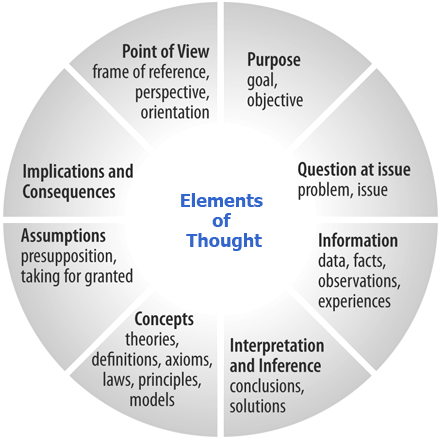

Why the Analysis of Thinking is Important
Everyone thinks; it is our nature to do so. But much of our thinking,
left to itself, is biased, distorted, partial, uninformed, or downright
prejudiced. If we want to think well, we must understand at least the
udiments of thought, the most basic structures out of which all
thinking is made. We must learn how to take thinking apart.
All Thinking Is Defined by the Eight Elements That Make It Up.
Eight basic structures are present in all thinking: Whenever we think,
we think for a purpose within a point of view based on assumptions
leading to implications and consequences. We use concepts, ideas and
theories to interpret data, facts, and experiences in order to answer
questions, solve problems, and resolve issues.
Thinking, then:
- generates purposes
- raises questions
- uses information
- utilizes concepts
- makes inferences
- makes assumptions
- generates implications
- embodies a point of view
Simply "Mouse Over" any object on the page to learn more about it.

Think About... Purpose
Your purpose is your goal, your objective,
what you are trying to accomplish. We also use the term to include functions, motives, and intentions.
You should be clear about your purpose, and your purpose should be justifiable.
Questions which target purpose
What is your, my, their purpose in doing________?
What is the objective of this assignment (task, job, experiment, policy, strategy, etc.)?
Should we question, refine, modify our purpose (goal, objective, etc.)?
What is the purpose of this meeting (chapter, relationship, action)?
What is your central aim in this line of thought?
What is the purpose of education?
Why did you say…?
Element: Purpose
All reasoning has a PURPOSE.
Take time to state your purpose clearly.
Distinguish your purpose from related purposes.
Check periodically to be sure you are still on target.
Choose significant and realistic purposes.

State the Question
The question lays out the problem or issue and
guides our thinking. When the question is vague, our thinking will lack clarity and distinctness.
The question should be clear and precise enough to productively guide our thinking.
Questions which target the question
What is the question I am trying to answer?
What important questions are embedded in the issue?
Is there a better way to put the question?
Is this question clear? Is it complex?
I am not sure exactly what question you are asking. Could you explain it?
The question in my mind is this: How do you see the question?
What kind of question is this? Historical? Scientific? Ethical? Political? Economic? Or…?
What would we have to do to settle this question?
Element: Question All reasoning is an attempt to figure something out, to settle some QUESTION, to solve some problem.
State the question at issue clearly and precisely.
Express the question in several ways to clarify its meaning.
Break the question into sub-questions.
Distinguish questions that have definitive answers from those that are a matter of opinion or that require multiple viewpoints.
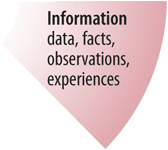
Gather... Information
Information includes the facts, data, evidence, or experiences we use
to figure things out. It does not necessarily imply accuracy or
correctness.
The information you use should be accurate and relevant to the question or issue you are addressing.
Questions which target information
What information do I need to answer this question?
What data are relevant to this problem?
Do we need to gather more information?
Is this information relevant to our purpose or goal?
On what information are you basing that comment?
What experience convinced you of this? Could your experience be distorted?
How do we know this information (data, testimony) is accurate?
Have we left out any important information that we need to consider?
Element: Information
All reasoning is based on DATA, INFORMATION and EVIDENCE.
Restrict your claims to those supported by the data you have.
Search for information that opposes your position as well as information that supports it.
Make sure that all information used is clear, accurate and relevant.
Make sure you have gathered sufficient information.

Watch Your... Inferences
Inferences are interpretations or conclusions you come to. Inferring is what the mind does in figuring something out.
Inferences should logically follow from the evidence. Infer no more or less than what is implied in the situation.
Questions to check your inferences
What conclusions am I coming to?
Is my inference logical?
Are there other conclusions I should consider?
Does this interpretation make sense?
Does our solution necessarily follow from our data?
How did you reach that conclusion?
What are you basing your reasoning on?
Is there an alternative plausible conclusion?
Given all the facts what is the best possible conclusion?
How shall we interpret these data?
Element: Interpretation and Inference
All reasoning contains INFERENCES or INTERPRETATIONS by which we draw CONCLUSIONS and give meaning to data.
Infer only what the evidence implies.
Check inferences for their consistency with each other.
Identify assumptions underlying your inferences.

Clarify Your... Concepts
Concepts are ideas, theories, laws, principles, or hypotheses we use in thinking to make sense of things.
Be clear about the concepts you are using and use them justifiably.
Questions you can ask about concepts
What idea am I using in my thinking? Is this idea causing problems for me or for others?
I think this is a good theory, but could you explain it more fully?
What is the main hypothesis you are using in your reasoning?
Are you using this term in keeping with established usage?
What main distinctions should we draw in reasoning through this problem?
What idea is this author using in his or her thinking?
Is there a problem with it?
Element: Concepts
All reasoning is expressed through, and shaped by, CONCEPTS and IDEAS.
Identify key concepts and explain them clearly.
Consider alternative concepts or alternative definitions of concepts.
Make sure you are using concepts with precision.
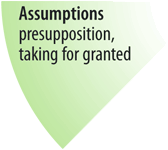
Check Your... Assumptions
Assumptions are beliefs you take for granted. They usually operate at the subconscious or unconscious level of thought.
Make sure that you are clear about your assumptions and they are justified
by sound evidence.
Questions you can ask about assumptions
What am I assuming or taking for granted?
Am I assuming something I shouldn’t?
What assumption is leading me to this conclusion?
What is… (this policy, strategy, explanation) assuming?
What exactly do sociologists (historians, mathematicians, etc.) take for granted?
What is being presupposed in this theory?
What are some important assumptions I make about my roommate, my friends, my parents, my instructors, my country?
Element: Assumptions
All reasoning is based on ASSUMPTIONS.
Clearly identify your assumptions and determine whether they are justifiable.
Consider how your assumptions are shaping your point of view.
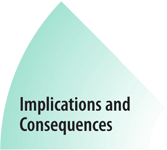
Think Through the...
Implications and Consequences
Implications are claims or truths that logically follow from other
claims or truths. Implications follow from thoughts. Consequences follow
from actions.
Implications are inherent in your thoughts, whether you see them or not.
The best thinkers think through the logical implications in a situation
before acting.
Questions you can ask about implications
If I decide to do “X”, what things might happen?
If I decide not to do “X”, what things might happen?
What are you implying when you say that?
What is likely to happen if we do this versus that?
Are you implying that…?
How significant are the implications of this decision?
What, if anything, is implied by the fact that a much higher percentage of poor people are in jail than wealthy people?
Element: Implications
All reasoning leads somewhere or has IMPLICATIONS and CONSEQUENCES.
Trace the implications and consequences that follow from your reasoning.
Search for negative as well as positive implications.
Consider all possible consequences.

Understand Your...
Point of View
Point of view is literally “the place” from which you
view something.
It includes what you are looking at and the way you are seeing it.
Make sure you understand the limitations of your point of view and that you fully consider other relevant viewpoints.
Questions to check your point of view
How am I looking at this situation? Is there another way to look at it that I should consider?
What exactly am I focused on? And how am I seeing it?
Is my view the only reasonable view? What does my point of view ignore?
Have you ever considered the way ____(Japanese, Muslims, South Americans, etc.) view this?
Which of these possible viewpoints makes the most sense given the situation?
Am I having difficulty looking at this situation from a viewpoint with which I disagree?
What is the point of view of the author of this story?
Do I study viewpoints that challenge my personal beliefs?
Element: Point Of View
All reasoning is done from some POINT OF VIEW.
Identify your point of view.
Seek other points of view and identify their strengths as well as weaknesses.
Strive to be fairminded in evaluating all points of view.
Key Concept:











